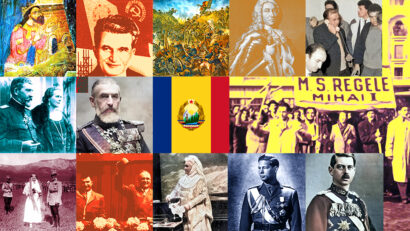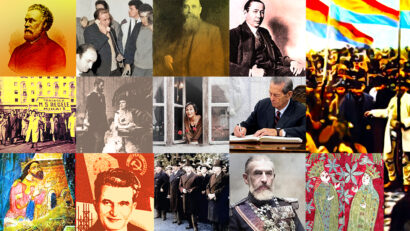December 1918 or the dawns of New Romania
At the end of WWI, the winners and the defeated alike were still marked by the tragedies they had experienced

Steliu Lambru, 28.11.2016, 14:34
At the end of WWI, the winners and the defeated alike were still marked by the tragedies they had experienced, but were relieved that the nightmare was eventually over. Romania was on the winners’ side, and the union with the regions of Banat, Bukovina and Transylvania in November and December 1918 will lead to the emergence of a new Romania, which many had not ever dreamt of. In 1918, new states were emerging on the map of Central and Eastern Europe, among which Greater Romania. The new map was actually a rearrangement of political structures based on national criteria and the ultimate manifestation of the spirit of modernity, of the anti-imperialist fight. The principle of national self-determination based on the ethnic majority principle played a major role in the process of setting up new state entities, a principle that is still functional today in international relations.
The Entente Alliance, the winner of WWI, imposed its conditions of peace on the defeated Central Powers. Apart from sustaining significant territorial losses, Germany, Austro-Hungary and their allies had to pay war damages. Romania had signed a treaty with the Entente in 1916 to enter the war, which entitled it to request the maximum when peace was concluded.
Here is next Ioan Scurtu, a professor of Romanian contemporary history at the Bucharest University, with further details: “A truce means the cessation of military hostilities and based on this truce they could convene the peace conference which started its proceedings in January 1919. On that occasion, treaties were signed with each state belonging to the Central Powers. The main treaty was with Germany, concluded on June 28, 1919, which also included provisions on Germany’s stand towards the other countries. In this case, Germany committed itself to recognising Romania’s new borders, to pay war damages, to pay compensations for the period of occupation and particularly for issuing lei, Romania’s national currency, by means of the General Bank of Wallachia, without the currency being backed by gold reserves, given that the coin was imposed by the occupant. Other provisions referred to the other states, this being the general treaty of the peace conference, which is known as the Versailles Treaty. The other treaties, signed with each and every defeated country, were signed at Versailles, too, but in other palaces, hence their different names”.
The Romanian nation in Austro-Hungary stood for the union with the Kingdom of Romania. On November 28, 1918, at the initiative of the Romanian National Council, the General Congress of Bukovina gathered in Cernauti (Chernivtsy), unanimously voted for the union with Romania, with support from the majority of German and Polish representatives. At the National Assembly in Alba Iulia, on December 1, 1918, the Romanians in Banat and Transylvania voted for the union with Romania. The Union Resolution was read out by Vasile Goldiş, and on December 3, a delegation made up of Alexandru Vaida Voevod, Vasile Goldiş and the Greek Catholic and Orthodox bishops, Iuliu Hossu and Miron Cristea, respectively, handed over the resolution of Alba Iulia to King Ferdinand I. On December 25, 1918, the King proclaimed the formation of Greater Romania, by issuing a royal decree.
But the new state needed international recognition, which was no easy thing to achieve. Ioan Scurtu: “The problem was that Ionel Bratianu, who led the Romanian delegation at the Peace Conference, believed that Romania would be treated on an equal footing with the other states. He expected that Romania would be treated like the other winners, just as they were equal during the battle. But the situation was different: a group of countries was set up, the Council of Five, which was actually a Council of Four: the US, Great Britain, France and Italy, which was the decision-making council. As was expected, Bratianu tried to impose the observance of the principle of equality among the winning countries. But the US President, Wilson, made it clear, before the participants in the conference, that the value of each country was equal to its military power. Romania, unlike the aforementioned countries, was not a big military power. This was the essential problem. Of course, there were problems regarding the signing of the peace agreements separately, the fact that the 1916 treaty did not make reference to Bessarabia (today’s Republic of Moldova), it only mentioned the Romanian territories under Austro-Hungarian rule. Then, there were problems related to damages, to the free transit on Romanian soil of freight and people, and of the goods belonging to the Entente Powers, and to the protection of minorities. Relative to this, I’d like to quote Bratianu’s declaration, expressing Romania’s readiness to grant the national minorities the rights that the other states included in the Council of the Four also granted. In other words, he called for Romania, Czechoslovakia, Yugoslavia and Greece not to be discriminated against. Of course, Bratianu’s proposals remained unanswered.”
Eventually, Prime Minister Ion I. C. Bratianu obtained the recognition of the new Romanian state, with the support of France, but the one who signed the peace treaties was Alexandru Vaida Voevod, the first Transylvanian personality to become prime minister of Greater Romania. Greater Romania was a big project which became reality and which involved the participation and contribution of all Romanians, and especially of some truly messianic personalities such as King Ferdinand I, his wife, Queen Maria, and Liberal politician Ion I. C. Bratianu. The royal text of the document issued on December 25, solemnly confirmed the nation’s will. In spite of a rather cold tone, a great satisfaction was resounding: “Taking note of the unanimous decision of the National Assembly in Alba Iulia. We have decreed and decree: The territories mentioned in the decision made by the National Assembly in Alba Iulia, of November 18 and December 1918 are and will always remain united with the Kingdom of Romania.”






























